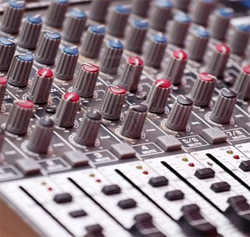
Digital Or Analog
This is the first question most people ask, and it should probably be the last.
Without figuring out the previous list (and I haven’t been all-inclusive in the list, there are dozens of smaller questions), you really can’t make a good decision about this.
Going digital just because it’s the latest thing and all the mega churches in town are digital are not good reasons to do so.
Digital has a lot of advantages, but it also carries some baggage. It’s important to know if the trade-off is worth it.
First, consider your existing complement of equipment; your snake, outboard gear, patchbays and the like. What kind of shape are they in, do you have enough, how easy is it to pull a new snake? How many stage inputs do you have now, and are they enough? Will a new snake be more cost-effective than a digital cable? Sometimes it is, believe it or not.
Think about who will be operating the board. Anyone with a reasonable amount of skill and time behind an analog board can learn a digital one—at least the lower end ones. However, who else uses it, and how easily will it be for them to make the transition? Most digital boards have permission setting ability that makes it easy to keep inexperienced operators out of trouble. But is there someone at your church who can figure out how to program the keys?
Digital boards have a lot of advantages, but they tend to be more complex to use and set up. On an analog board, it’s easy to teach someone how to use the Aux sends or EQ. It’s right there in front of you and it’s easy to visualize. A digital board has a bunch of multi-purpose encoders and it’s easy to get lost if you’re not paying attention.
I’ve done a lot of mixing in my career, and once in a while I still adjust the wrong monitor mix on the M7 or select the wrong channel. Mastery of digital is by no means impossible, but it does take time. Are all the stakeholders (volunteers, leadership, board, etc.) prepared for that?
If you already have a significant investment in quality outboard gear (compressors, gates, FX, etc) and you have a decent snake installed, going digital may not make a lot of sense if all you really need are more inputs. On the other hand, if the snake is old and failing, you’re always short gates and comps and you really could use another 16 stage inputs, a digital upgrade can fit the bill perfectly.
Even with digital you have some choices. Some boards, like the Yamaha M7 and LS9 are hybrid boards; that is they are designed to be dropped into an existing analog infrastructure. You can get digital snakes for them, but they add significantly to the cost. The work great if you have an existing snake that does the job. Others, like the RSS M-400 at the low end and the Digidesign Venue and Profile at the high end, are based around a digital snake concept. Those are perfect if you need the advantages of digital and you either don’t have a snake, it’s not big enough or the one you have is failing.
Decisions, Decisions
Clearly, there are lot of questions to ask when buying a new board. I haven’t even tried to be exhaustive, but this structure will get you thinking. You really need to think it through. Then ask some people to help you think it through. Then go play with the board. Whether you’re spending $2,000, $20,000 or $50,000, it’s a big deal. That’s money that could be going to a dozen other areas of ministry, and it needs to be spent wisely.
We also need to invest for the long-term. Asking for a new board every 3 years because you chose poorly is not a way to win friends and influence people. So think it through…everyone will be better off!
Mike Sessler is the Technical Director at Coast Hills Community Church in Aliso Viejo, CA. He has been involved in live production for over 20 years and is the author of the blog, Church Tech Arts . He also hosts a weekly podcast called Church Tech Weekly on the TechArtsNetwork.
